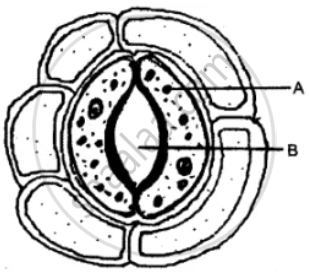Advertisements
Advertisements
प्रश्न
उत्तर
The opening and closing of stomata depend upon the changes in the turgidity of their guard cells. Due to the absorption of water, the guard cells become turgid. Their inner walls are pulled apart by their outer wall. The gap between the guard cells becomes wider and stomata open. When guard cells are flaccid due to loss of water, the outer walls are not stretched, their inner walls are not pulled apart decreasing the gap between the guard cells and stomata close.

APPEARS IN
संबंधित प्रश्न
Name the following:
openings on the stem through which transpiration occurs.
Given ahead is the diagram of an experimental set up to study the process of transpiration in plants. Study the same and then answer the question that follow:

Why are glass slides placed over the dry cobalt chloride papers?
Where are stomata generally found?
Give Reasons for the following:
Guard cells are small in size and are kidney-shaped in outline.
The diagram below represents a structure found in a leaf.

Study the same and answer the questions that follow:
(i) Name the pis labeled A and B.
(ii) What is the biological term for the above structure?
(iii) What is the function of the part labeled A?
(iv) Mention two structural features of A, which help in the function mentioned in (iii) above.
(v) Where is this structure likely to be found in a leaf?
(vi) The above structure helps in the process of transpiration. Explain the term transpiration.
(vii) How many other cells are found surrounding this structure as seen in the diagram?
The figure below represents the vertical section of a leaf:

(i) Name the parts labeled 1 to 5.
(ii) What do the two arrows (dotted and solid) indicate in the day time and at night?
(iii) Could you add one more arrow in the figure? If yes, what for?
(iv) How many leaf veins have been shown in this section?
Given below is an experimental set up to study a particular process:

(i) Name the process being studied.
(ii) Explain the process named in (i) above.
(iii) Why is the pot covered with a plastic sheet?
(iv) Mention one way in which this process is beneficial to the plant.
(v) Suggest a suitable control for this experiment.
Name the following:
A plant having sunken stomata.
State the Location:
Stomata
State the Location:
Guard cells
